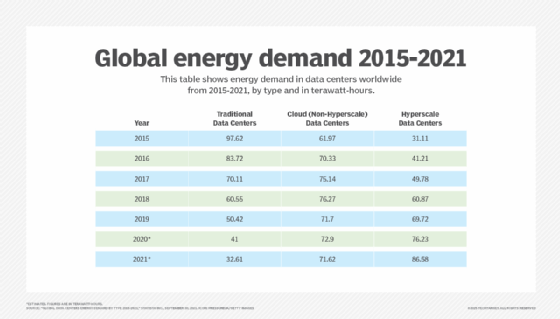
Getty Images
Data center environmental controls a high priority for admins
More data growth and tightening financial conditions are coming. Protect data center assets in 2023 through environmental controls like cooling, humidity and others.
Data center growth is both a thing of the past and a thing of the future. Organizations that don't cut corners when they design and manage their data centers can position themselves well for long-term success.
2022 was a year characterized by volatility and uncertainty. Supply chain problems, high energy prices and deteriorating financial markets have put a premium on efficiency and cost management -- in the face of ever-increasing data growth. Russia's invasion of Ukraine and the subsequent consequences to energy markets also drove increased interest in energy-efficient data center practices as companies look to go green -- a goal that was already well underway but amplified by the events of 2022.
All told, TechTarget readers looked to streamline their operations and better manage their data centers for efficiency and longevity in 2022. This means improving operations, improving asset service life and saving energy. This recap in tips examines controls data center admins and managers can use to increase efficiency, save energy, protect data center assets and improve the service life of those assets.
Keep an eye on energy use
Data center energy usage is one of the key drivers of scrutiny around data center expansion. Data centers consume energy through powering various assets like servers and storage racks, and hyperscale data center energy demand has been rising in recent years.
Recent data showed that energy demand from traditional data centers has been steadily declining. But cloud providers and hyperscalers have remained relatively steady and have increased energy demand, respectively.

To effectively manage energy usage and carbon footprints, implement more renewable energy sources, design data centers for efficiency from the outset and measure power usage effectiveness to find areas of improvement. Keep energy use in mind not only to cut costs and reduce environmental impact, but also to show clients and prospective clients the organization is committed to sustainability and environmental health.
Prioritize data center cooling
Having sufficient data center cooling systems is a key driver of energy efficiency. Data center assets can be damaged, lead to data loss and have a lower service life if they run too hot. Inefficient cooling can lead to more energy use that optimal cooling systems don't need. Organizations that keep assets healthy won't need to replace them as often.
Organizations can look to various cooling and design tools to keep their assets healthy. Air cooling, hot aisle/cold aisle layouts and liquid cooling are all options to ensure data center assets remain at optimal temperatures. ASHRAE recommends that IT equipment remains between 18 and 27 degrees C (64.4 to 80.6 degrees F).
In the new year, look to recalculate how to cool data center assets and find ways to improve cooling systems.
Control data center temperature and humidity
Like temperatures of assets themselves, temperature and humidity levels in a data center are crucial for data center health. Condensation on data center equipment inevitably leads to damage and equipment failure.
Data centers that use outside air for cooling can have trouble regulating humidity since outside humidity constantly changes. Organizations can work with cooling manufacturers to control humidity and install detection systems to avoid excess humidity.
Hedge risks against data center fires
Data centers are inherently ripe for fire risks due to massive electricity use and combustible material. Fire mitigation and detection are crucial for data centers to hedge against fire risks, detect fires early if they occur and find ways to improve their infrastructure so fires are unlikely to occur.
Have a strategy for data center fire protection to prevent fires from disrupting operations. Review existing systems, such as gas or water suppression systems, to improve or expand on fire prevention and protection, and minimize damage if a fire occurs. Organizations can design their own and can also look to standards such as those from the National Fire Protection Association for guidance.
Protect your most important capital -- human capital
Data centers are a minefield for staff accidents. Electrical hazards, fire risks and fall risks all present dangers to data center staff. Have procedures to protect data center staff, or dedicate staff, such as a safety or facility manager, to manage safety risks and to keep staff members safe.
Train staff members on how to work safely in a data center and how to respond to potential threats like fires. Doing so not only boosts morale, but guarantees staff can safely maintain the organization's infrastructure and assets for business and technological success.




